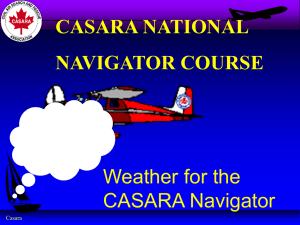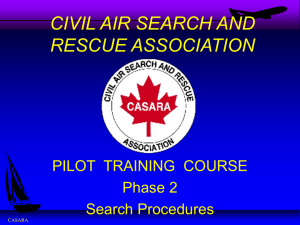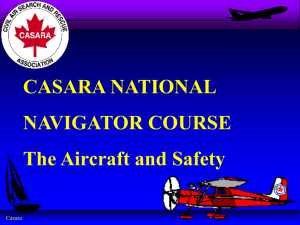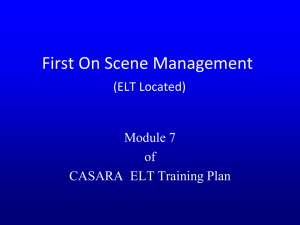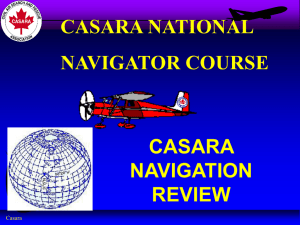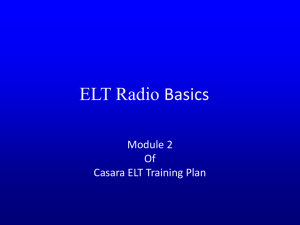4-SAR-PROCEDURES
advertisement
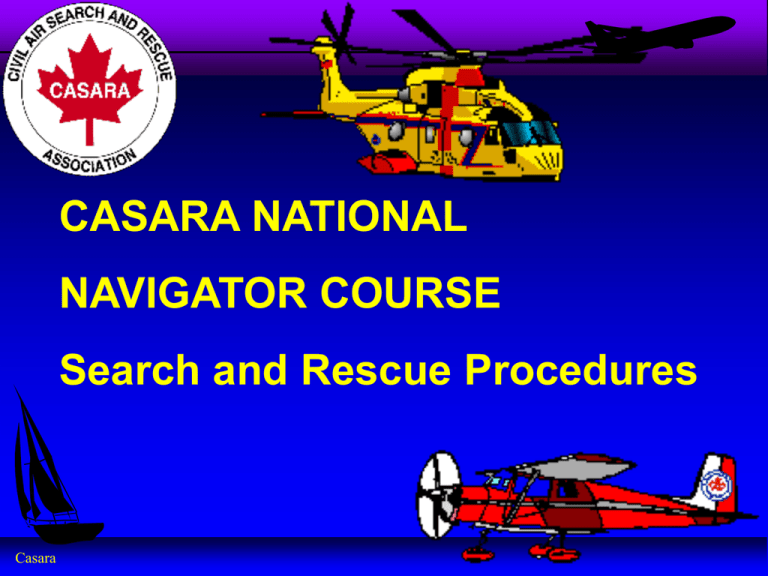
CASARA NATIONAL NAVIGATOR COURSE Search and Rescue Procedures Casara CASARA Navigator Course Table of Contents: SEARCH and RESCUE PROCEDURES The Search Plan Area Coverage Search patterns – Visual Search patterns – Electronic Reports and Returns Casara The Search Plan Casara Once an Aircraft or vessel has been reported missing, the search planning process begins. To give you an idea of where your search tasking originates, we will review the factors the Searchmaster must consider in his/her search planning. The Search Plan Casara When the Searchmaster draws up a SEARCH PLAN he/she considers the following; Estimate the datum; Determine the size of the search area; Select the appropriate search patterns; Determine the desired area coverage; and, Develop an optimum and attainable search plan Developing the Search Plan Casara Estimate the DATUM; Determine the position of the emergency For marine cases, calculate the effect of tide and current on the survivors. Developing the Search Plan Casara Determine the size of the search area; Allow for errors in position estimates,; Allow for navigation errors of the search units; and, Drift variables of wind and tide. Developing the Search Plan Casara Select the appropriate search plan; Consider the size of the area; The type of terrain; and, The capabilities of the search units. Developing the Search Plan Casara Determine the desired area coverage; Factors affecting probability of detection; Tree coverage, snow, water conditions Track spacing; Visibility from the search unit Visibility and size of the object. The smaller the Track Spacing, the more units required The number of sweeps. A factor of the # of units, weather, daylight, etc Developing the Search Plan Casara Develop an optimum and attainable search plan Consider the number of search units available and other factors and circumstances. Search Planning Methods Casara Based on least and greatest values of all unknown or uncertain factors: – Such as earliest and latest time of the incident, winds, tides, navigation errors, etc.. Plots minimum vectors and maximum vectors that the search object may have drifted. The search area then incorporates the whole of this area. Search Planning Methods The two systems that will most likely be used to task a CASARA resource for aviation incidents over land are: Casara The Canadian Search Area Definition Method (CSAD) or The Mountain VFR (MVFR) Method Search Planning Methods Casara The Mountain Visual Flight Rules (VFR) Method acknowledges that: Crashes are likely to occur along the whole of the intended track. Very few occur before the Last Known Position (LKP). Sites cluster close to the intended track. Search Planning Methods Casara Probability of Containment (POC) area stretches along the entire length of the track. If the intended route is not known with any certainty, all likely routes must be covered. – From 5 miles before LKP to 5 miles beyond the intended destination, Mountain Visual Flight Rules (VFR) Method AREA A – Entire length of the intended track, 5 miles on either side, – The same coverage on any alternate routes than may have been used. Casara Mountain Visual Flight Rules (VFR) Method AREA B – Entire length of the intended track, 10 miles on either side, – From 10 miles before LKP to 10 miles beyond the intended destination,. – The same coverage on any alternate routes than may have been used. Casara Mountain Visual Flight Rules (VFR) Method Casara Mountain Visual Flight Rules (VFR) Method (alt routes) Alternate Routes Casara Canadian Search Area Definition (CSAD) Method Casara Two probability areas are computed as follows: AREA 1- a rectangle 10 nautical miles (NM) each side of the track, beginning 10 NM before LKP and extending 10 NM beyond the destination. AREA 2- a rectangle 15 NM each side of the track, beginning at LKP and extending 15 NM beyond destination. Area 2 includes the overlapping portion of Area 1. Canadian Search Area Definition 10 0 -10 Casara 20 Search Plan Once the Search Plan has been established and resources assigned, the Searchmaster must decide on the search sequence and search patterns to be used throughout the search process. Casara Search Plan-Sequence Casara PHASE I For searches where the CSAD or MVFR method is used. PHASE I is a preliminary electronic and visual search effort performed before all the necessary assets arrive in the search area. The intent is to provide a platform to spot a visual or electronic signal from the survivor or short term evidence of the crash site. Carry out track crawls of the missing aircraft’s intended route checking the LKP and destination for take-off and landing incidents. Search Plan-Sequence Casara PHASE I cont’d Carry out an electronic search to detect any distress beacon signals. Carry out a cooperative target/survivor search over the high probability area . Covering 15 miles either side of tract(s), including 15 miles before LKP and beyond Destination (use10 miles for MVFR). Search Plan-Sequence PHASE II (for all CSAD track lengths) Search AREA ONE in the following sequence: The last quarter of track from the intended track outwards. The third quarter of the intended track. The first quarter of the intended track. The second quarter. The overfly area commencing at Destination. The underfly area commencing at LKP. Casara CSAD Search Sequence 4th 3rd 6th Casara 2nd 1st 5th Search Patterns-Plan Casara PHASE II (for all MVFR track lengths) Search AREA ONE in the following sequence: The third quarter of track from the intended track outwards. The last quarter of the intended track. The second quarter of the intended track. The third quarter. The overfly area commencing at Destination. The underfly area commencing at LKP. MVFR Search Sequence Casara Search Plan-Sequence Casara PHASE III Expand the search to AREA TWO and use the same sequence as in Phase II for the appropriate type of search area. For MVFR, any valleys, dead-end canyons, passes than may have been accidentally taken by the missing aircraft should also be covered. Search Patterns-General Casara Once the search area has been defined and the search sequence established, the search assets are given their specific taskings. They will be assigned a specific portion of the search area using one of three possible methods GEOREF, The Track Line Method, or The Corner method by giving the Latitude and Longitude positions of each corner. Search Patterns-General Casara GEOREF has been discussed earlier and the Corner Method is self evident but the Track Line method requires clarification. Once the likely track of the aircraft has been determined and AREAs ONE and TWO or AREAs “A” and “B” (MVFR), the track is divided into 10 mile segments starting at the LKP ( the track line before the LKP is a MINUS value -15, 10 etc). Search Patterns-General Casara A specific portion of the search area will be assigned by giving: The AREA (ONE and/or TWO), “A” and/or”B” for MVFR. Whether the AREA to be covered is North or South (East or West) of the track Line “miles along the track line”.. Example; – Search AREA ONE and TWO NORTH from 10 miles to 20 miles. Canadian Search Area Definition Assigned Area 10 0 -10 Casara 20 Search Patterns Casara As part of your tasking you will also be told the type of search assigned and the search parameters. Different search patterns are used for different purposes but you will be assigned one of the following: Electronic Search Track Crawl; Creeping-Line-Ahead (CLA); Parallel Track; Expanding Square; Sector Searches; Contour Search, or; Coast Crawl. Electronic Search Casara ELTS can be heard by satellites some 25,000 miles overhead but at our searching level there are some limitations. Because of the limited life of most ELTs it is essential to saturate the high probability areas as soon as possible. Assuming a heavily treed area and level terrain, we should only expect to receive an ELT at approximately 3 nm if we flew at 1000 feet AGL. At 5000 feet the range would be approximately 15 nm. Essentially, the higher you fly the better the range. Electronic Search Casara Any Normal visual search pattern which allows you to cover a great deal of area in a short time is fine for an electronic search but the flying altitude is normally not appropriate for visual searching. Normal cruising airspeed will not reduce the effectiveness of an electronic search and will improve the rate at which you cover the area. False “On Top” indications should be confirmed with a second “On Top” from a different direction. Electronic Search Casara The most effective searches are Parallel Track or a creeping Line. Search Width and Track spacing should anticipate nominal beacon reception for the altitude, area and terrain. Prior to take-off, the effectiveness of the electronic homer should be confirmed using a hand held radio on an appropriate frequency. ELT Homer Operation Casara The following hints are not meant to replace reading the pamphlets on the homer, watching the training video and flying training flights. Once the search aircraft is airborne, the homer may be operated by the navigator or one of the spotters . It is important for the operator to be able to hear any signal on the homer and still be in instant communication with the pilot. Some zones use a small homer earphone under the aircraft headset. ELT Homer Operation Casara When you are searching for a signal. The homer should be set to “receive” with the VOLUME and SENSITIVITY towards the “Maximum” range. Once a signal is received. The Homer is selected to “Direction Finding” and the VOLUME and SENSITIVITY reduced to keep the “needle” from deflecting to maximum (see diagram). Banking of the aircraft will cause the needle to swing so bearings should be taken with the aircraft level and steady. ELT Homer METER MODE FREQUENCY SENSITIVITY VOLUMN Casara ELT Homer Operation Casara Changing VOLUME and SENSITIVITY will also affect the “swing” of the needle so changes should be made in stages and not constantly. The aim is to keep the needle as sensitive as possible without letting it swing to either end of the meter. As you get close to the “On-Top” put the VOLUME/SENSITIVITY at a suitable level and leave it there Minimize your heading changes as well. Try to identify the “On Top” by the change in volume and any unusual movement of the needle. ELT Homer Operation Casara Once you assess an “On Top”, call it out and mark the position on the map or with the GPS. Continue on the track just to confirm that this was the “On Top”. To confirm and refine the position, conduct a second homing from a 90 degree position. Regardless of the “On Top”, the ELT should be close to where the two tracks cross. To prepare for those times when you do not have a homer or it is not working, review and practice the “Aural Null” procedures in the CASARA Training Manual. Search Patterns VISUAL SEARCH PATTERNS A Tasking for a visual search pattern will include: The area to be searched The type of pattern Commence search point The search elevation Search visibility and/or track spacing Casara Search Briefing Casara As part of your SEARCH TASKING, you would normally receive a SEARCH BRIEFING. This should include A comprehensive description of the weather conditions and forecast. A description of the search object and all pertinent details (see the SAR Briefing / Tasking in the NSM). Information on any other SAR assets in the area. Search Briefing Casara Communication requirements (times, agencies and frequencies). Your specific search tasking. A CASARA crew shall only accept the proposed tasking if their equipment and crew capability will permit completion of the task with safety. Often CASARA crews receive their taskings by phone and it is the responsibility of the crew to ensure that they have all the necessary information. Search Tasking Casara AREA TO BE SEARCHED The area to be searched will normally be given in GEOREF, in reference to the Track Line or by designating the corners of the area. THE TYPE OF PATTERN Visual search patterns will be discussed later. COMMENCE SEARCH POINT Normally specified as a corner, i.e.. North East corner. Some searches specify the direction of movement as well Search Tasking THE SEARCH ELEVATION This is the height above the ground and any obstacles that you are expected to fly over. Casara As the ground elevation will change throughout the area, it is your responsibility to inform the pilot so that he can adjust his flight level. In the case of obstacles, it would not be effective to fly a 500 ft search at 500 feet above a 1200 foot tower so you must be aware of prominent obstacles and coordinate with the pilot to fly the most effective (but safe) altitude. Search Tasking THE SEARCH ELEVATION The elevation of the search aircraft is a trade-off. Casara The lower you go the less you can see to the side and the slower you must fly to avoid making the ground below a blur for the spotters. 1500 ft & 11/2 nm visibility: During the initial part of the search, assets are tasked to fly at 1500 feet with a track spacing of 3 nm – At this elevation and width you are searching for obvious signs of a crash or signals from a survivor Search Tasking Casara 1000 ft & 1nm visibility: As the search proceeds you are now flying at 1000 feet above ground with 2 nm between tracks You are primarily looking for signs of a crash or signals from a survivor. 500 ft & 1/2nm visibility: In the most intense part of the search you are flying at 500 feet AGL with 1 mile between tracks. You are hoping to spot pieces of the wreckage, manmade signals or persons on the ground. Search Tasking SEARCH VISIBILITY – TRACK SPACING Search visibility is the distance you can expect to see on EITHER side of the aircraft. Casara Track spacing is twice the search visibility since you would see ½ mile to the side on leg one and ½ mile into the same space on the next leg (see the next slide). It is a fact of searching that fewer targets will be spotted at the extreme visibility distances and directly below the aircraft. Search Tasking Casara The visibilities corresponding to 1500, 1000 and 500 feet, 1 1/2, 1, and ½ approximate an angle of 28 degrees from the horizontal (72 degrees from the vertical). There is always some confusion between “Visibility” and “Track Spacing”. “Visibility” is the distance a spotter is expected to search on his side of the aircraft. “Track Spacing” take account of the fact that the spotters scan one “visibility on each side of the aircraft so the next track is two times visibility abeam. Search Visibility And/or Track Spacing Visibility Track Spacing Casara Search Tasking TYPE OF SEARCH PATTERN The various types of search plans have different uses and are flown to differing parameters specified by the Tasking Agency. Casara If you feel that the pattern specified is not appropriate, contact the Tasking Agency to discuss it. You are not permitted to alter the search without letting the Search Master know. Once tasked with an area to search, you would normally be expected to complete the search even if it required you to return and refuel for a second flight. Search Tasking Casara With the exception of the transit to and from the search area the aircraft will be expected to remain WITHIN the boundaries of the designated search area unless specifically authorized to operate outside. When searching inside the boundary of the search area it is important to continue searching in the turns. Time should be taken approximately every thirty minutes to allow the spotters to take a rest. This is best done prior to starting a new leg by orbiting a reference on the ground. Search Tasking Casara The transit altitude to and from the search area would normally be above any search altitudes in use. Any descent to search altitude would normally be inside your search area unless you were in communication with the aircraft in the adjacent area to ensure that there was no conflict. While transit speed will be at normal cruise speed, any visual search should be at a reduced but safe speed to allow the spotters a clear view of the ground and a chance to complete their scan in an effective manner. Track Crawl Casara The Track Crawl is a search conducted along, and on either side of, the intended flight route of the missing aircraft. One type specifies the search unit returns to the origin while the other type specifies that the search aircraft breaks off the search at the opposite end of the track from where the search began (Non-return) Normally used as the initial search action. Track Crawl Casara It is based on the assumption that the search object will be close to the intended track, or there will be survivors capable of signaling when they hear or see the search unit. Track Crawl - Return Searchmaster identifies: The missing aircraft’s LKP and intended route to destination. The search altitude to be flown; and The visibility distance. Casara Track Crawl - Return Search crew starts one visibility short of the LKP and begins to fly a track parallel to the intended flight to destination plus visibility distance, offset one visibility distance to the side of the intended track. At the end of the search track, the aircraft crosses over to the other side of the track and flies the return leg offset one visibility distance to the other side. See following diagram. Casara Track Crawl -Return LKP Destination 3nm visibility 3 miles Casara Track Crawl – Non-Return Searchmaster identifies: The missing aircraft’s LKP and intended route to destination. The search altitude to be flown; and The visibility distance. Casara Track Crawl – Non-Return Search crew starts one visibility short of the LKP and begins to fly along the route of the intended flight to destination plus visibility distance. At the end of the leg the aircraft returns towards the start offset two visibility distances to one side or the other. At the “Start” end the aircraft crosses over to the opposite side to fly back towards the destination offset at twice the visibility distance from the intended flight route. See the following diagram. Casara Track Crawl Non-Return 3nm 6nm LKP 6nm Casara Destination 3nm Creeping Line Ahead (CLA) Searchmaster identifies: The area to be searched; The search altitude to be flown; The visibility distance; The Commence Search Point: and, The direction of flight. Casara Creeping Line Ahead (CLA) The search aircraft proceeds to the Commence Search Point. They fly the first track in the specified direction one visibility distance inside the search boundary. The second track is the reverse direction two visibility distances offset. The aircraft continue reversing track and offsetting until the area has been covered. All turns and tracks must be completed inside the search area unless the conditions stated earlier exist. Casara Creeping Line Ahead (CLA) This search can be easily entered into an available GPS by using Ozi–Explorer or manually by establishing a NEW “ROUTE” using the “USE MAP” mode. Using the known leg length and initial track from the commence search point, draw the first leg and second waypoint. Casara Creeping Line Ahead (CLA) Subsequent legs and waypoints are plotted on the GPS using a 900 offset equal to two times visibility for WP #3 then the reciprocal of the initial track for WP #4 and so on. When the pattern is complete, the WPs can be entered into a route. Casara Creeping Line Ahead (CLA) Casara Parallel Track The PARALLEL TRACK is similar to the CLA but in a direction parallel to the intended track of the missing aircraft. Searchmaster identifies: The area to be searched; The search altitude to be flown; The visibility distance; The Commence Search Point: and, The direction of flight. Casara Parallel Track Casara The Parallel Track pattern can be entered in the GPS in the same manner as the CLA. Parallel Track – Single Aircraft Casara Expanding Square This pattern is only applied to a relatively small area and is used where there is an LKP and the object or people may have drifted or moved away in any direction for a small distance for example Survivors have left the crash scene, You have completed an ELT homing and no target is visible A campsite is located but the individuals are not there; or For marine searches where the LKP is known and only a short time has elapsed. Casara Expanding Square Searchmaster identifies: The LKP; The search altitude to be flown; The visibility distance; and, How far from datum the search area will extend. Casara Expanding Square The search aircraft proceeds to the LKP. Note that there are no real “boundaries” to this search. In addition, by approaching the LKP on the same track as first search track you can simplify your entry to the search. Since no initial track is specified, I always enter on North (True) and make all turns to the right. Depart the LKP on a track of North for 2 X VISIBILITY then turn RIGHT. Casara Expanding Square Fly EAST for 2 X VISIBILITY then turn SOUTH. Fly SOUTH for 4 X VISIBILITY then turn WEST. Fly WEST for 4 X VISIBILITY and return to the NORTH. Continue increasing the legs lengths by 2 X VISIBILITY every second leg with 900 right turns at the end of each leg until you reach the specified extension from DATUM (LKP). Casara Expanding Square This search can be entered on the GPS with Ozi-Explorer or manually plotted using the technique described earlier. It can also be flown by eye using a suitable scale on the GPS. Time is of the essence in commencing this search and it is a complicated one to plot. Flying by eye on the GPS with track enabled is simple, fast and accurate. Casara Expanding Square Casara Sector Search Casara Used when the LKP is established with a high degree of accuracy and the search area is relatively small, for example: Persons lost in the bush and their whereabouts are established in a small area. When an “On Top” is established on an ELT or PLB but no one is seen. Sector Search Searchmaster identifies: The LKP and intended route to destination. The search altitude to be flown; and The leg length (radius) of the sector search. While no “visibility” is specified, the search altitude is tied to a specific “VIS” (1500 ft = 1 ½, 1000 ft = 1 and 500 ft = ½). Casara Sector Search Once again, for simplicity’s sake, fly the initial track on NORTH (True) with all turns right. Also set up to commence the search one LEG LENGTH short of the LKP. After crossing the LKP, the aircraft proceeds NORTH (true) for 1 X LEG LENGTH, then turns 120 degrees (to the right) to track 1200(t) to intercept the next inbound leg of 2400(t) which takes the aircraft through the LKP and out 1 X LEG LENGTH on the other side. Casara Sector Search The pattern continues with 1200 turns at the end of each outbound leg. If the search is to continue after all sectors have been completed, the search can continue off set by 30 degrees (to the right) with the initial leg now at 0300(t) Spotters should continue to search throughout this short search. Casara Sector Search Casara Sector Search This search can be programmed on the GPS from the Ozi-Explorer or it can be entered in the “NEW ROUTE” mode using the map. Because the route will intersect itself a number of times, legs which cross over the LKP should not use a WP at the LKP but continue out to the outer limit of the search Casara Sector Search Casara Sector Search For a rapid response, the search can be flown by using the GPS readout to the LKP as a VOR / DME type of facility if you are familiar with this type of navigation. On the initial run in, you would require the LKP to read 0000(t) with the mileage counting down from VIS to 0. Outbound, the bearing would be the reciprocal (1800(t)) with the mileage increasing to approximately the VIS. . At VIS outbound, the aircraft turn 1200 and arcs at the VIS to intercept the next inbound 2400(t). And so on. Casara Contour Search Before flying a Contour Search, the crew must have a thorough understanding of mountain searches and mountain flying techniques: An excellent précis on flying Contour Searches is contained in the CASARA Training Manual and the navigation requirements will not be discussed here. Casara Contour Search Patterns are flown left or right hand turns based on aircraft requirements and the terrain to be searched. Casara Coast Crawl – Shoreline Search Normally used where there is a missing vessel with casualties in the water : Also used where a person has gone missing either from the shore or while at sea. Should be done at low tide but cover up to the high tide mark. Because the object to be sighted may be small, a coast crawl is normally done at low altitude and slow speed. Casara Coast Crawl – Shoreline Search Searchmaster identifies: The start and finish point along the coast . The search altitude to be flown; and The visibility distance. And how far offshore you are to search . Casara Coast Crawl – Shoreline Search Commence search at the nearest end of the search area. Follow the coast line ensuring you check any small bays or inlets (with perhaps a second pass to ensure coverage). At the end of the search area, off set by 2 X VISIBILITY and using your best assessment, return following the same route but further offshore. Casara Coast Crawl – Shoreline Search Continue until the distance off shore can no longer be estimated. At this point you can establish two WPs and plot a CLA to the defined distance off shore. Casara Coast Crawl – Shoreline Search Casara Notice of Crash / Casualty Location Casara Whenever a crash or a casualty is located , it is critical that the information be conveyed in an accurate, professional, complete and discreet manner. Any errors or misinterpretations can lead to devastating consequences as we witnessed at the mine disaster in West Virginia. Twenty three miners were reported “alive” when in fact there was only one severely injured survivor. The NOCL is only sent where you judge that you have located the search object or related survivors. Notice of Crash / Casualty Location Casara NOCL Message Format Also refer to inside back cover of CASARA Handbook ALPHA (identification) Affirmative - positive identification that the object sighted is the search object or Negative - unable to positively determine that the object is the search object. Casara Note that you figure that this is the search object hence the NOCL but you don’t have positive identification (view of the registration for example). NOCL Message Format BRAVO (position) An eight or nine digit group denoting position in Latitude and Longitude without north or west being used. Bravo 4846 5237 Casara NOCL Message Format CHARLIE (casualties) NEGATIVE - when no survivors or casualties can be seen. NUMBER – – – – Casara - any number of survivors or casualties actually seen, followed by: Undetermined - when the status of the survivors or casualties cannot be determined Red - Immediate treatment and evacuation (priority 1) Yellow - Early treatment and evacuation (priority 2) Green - Routine treatment and evacuation (priority 3) NOCL Message Format CHARLIE (cont’d) – Blue - Deferred treatment and evacuation (priority 4) – White - Uninjured – Grey - Missing – Black – Dead Note: This information on the medical conditions of victims can only be transmitted after investigation by SAR TECHS or other medically trained personnel. Casara NOCL Message Format DELTA (terrain – quickest way to provide assistance) ONE - side of hill, also indicate N,S, E or W slope TWO - in valley, also indicate N, S, E or W side of valley floor THREE - in level country FOUR - heavily wooded area (can be used with one, two or three FIVE - in water: ALPHA - near shore BRAVO - well off shore Casara NOCL Message Format ECHO (Type of assistance) Casara ONE - request authorization to deploy SAR Techs TWO - a helicopter will be required THREE - a ground party could reach the location in good time FOUR - a rescue boat will be required NOCL Message Format FOXTROT (remarks) Remarks - Briefly provide any detail which will allow JRCC to initiate appropriate action, bearing in mind that the transmission is not secure. For example: – inform how long you can remain on the scene – request an ETA for onscene of SAR aircraft or relief aircraft Casara Air Tasking Debrief The Searchmaster, JRCC or the Search Coordinator draw up the master plan for a search and assign the taskings but they are not in the air with the crews and only get an idea of the success or shortcomings of their plan when they read with the debriefings provided by the crews at the end of the flight. They use this information to determine the next days effort and to possibly eliminate areas from the search. Phone, fax or e-mail in directly, or if this is not possible relay through nearest FSS or ATC unit. Casara Air Tasking Debrief Casara Casara

